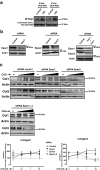Adenosine A2A receptor (A2AR) is a fine-tune regulator of the collagen1:collagen3 balance
- PMID: 23749290
- PMCID: PMC3889389
- DOI: 10.1007/s11302-013-9368-1
Adenosine A2A receptor (A2AR) is a fine-tune regulator of the collagen1:collagen3 balance
Abstract
Adenosine is a potent endogenous anti-inflammatory and immunosuppressive metabolite that is a potent modulator of tissue repair. However, the adenosine A2A receptor (A2AR)-mediated promotion of collagen synthesis is detrimental in settings such as scarring and scleroderma. The signaling cascade from A2AR stimulation to increased collagen production is complex and obscure, not least because cAMP and its downstream molecules PKA and Epac1 have been reported to inhibit collagen production. We therefore examined A2AR-stimulated signaling for collagen production by normal human dermal fibroblasts (NHDF). Collagen1 (Col1) and collagen3 (Col3) content after A2AR activation by CGS21680 was studied by western blotting. Contribution of PKA and Epac was analyzed by the PKA inhibitor PKI and by knockdowns of the PKA-Cα, -Cβ, -Cγ, Epac1, and Epac2. CGS21680 stimulates Col1 expression at significantly lower concentrations than those required to stimulate Col3 expression. A2AR stimulates Col1 expression by a PKA-dependent mechanism since PKA inhibition or PKA-Cα and -Cβ knockdown prevents A2AR-mediated Col1 increase. In contrast, A2AR represses Col3 via PKA but stimulates both Col1 and Col3 via an Epac2-dependent mechanism. A2AR stimulation with CGS21680 at 0.1 μM increased Col3 expression only upon PKA blockade. A2AR activation downstream signaling for Col1 and Col3 expression proceeds via two distinct pathways with varying sensitivity to cAMP activation; more highly cAMP-sensitive PKA activation stimulates Col1 expression, and less cAMP-sensitive Epac activation promotes both Col1 and Col3 expression. These observations may explain the dramatic change in Col1:Col3 ratio in hypertrophic and immature scars, where adenosine is present in higher concentrations than in normal skin.
Figures




References
Publication types
MeSH terms
Substances
Grants and funding
LinkOut - more resources
Full Text Sources
Other Literature Sources

